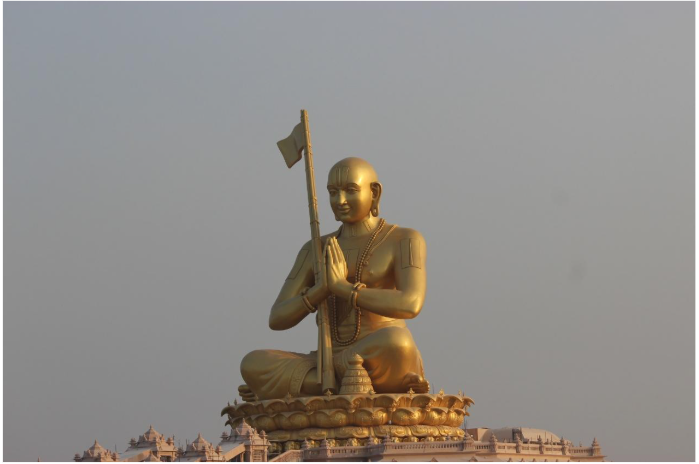Statue of Peace: A Symbol of Harmony and Social Reform in India
The unveiling of the Statue of Peace of Swami Ramanujacharya in Srinagar marks a heartwarming milestone in India’s journey toward peace, inclusivity, and social justice. This beautiful statue commemorates one of India’s greatest philosophers and social reformers. It also serves as a shining beacon of hope and unity for the people of Jammu and Kashmir and beyond. People from all walks of life can visit and draw inspiration from his message. As a result, the site attracts visitors who seek harmony and wisdom.
The Life and Teachings of Swami Ramanujacharya
Swami Ramanujacharya, born in 1017 in Sriperumbudur, Tamil Nadu, stands out as a Vedic philosopher and pioneering social reformer. He travelled across India, advocating for equality, compassion, and the democratisation of spiritual knowledge. Ramanujacharya promoted the philosophy of Vishishtadvaita (qualified monism), which emphasises that the divine and the universe are distinct yet inseparably connected.
He challenged the prevailing notions of caste and social hierarchy. He brought the treasures of Vedic literature to the common people and inspired the Bhakti movement. His teachings influenced generations of mystic poets and reformers, including Kabir, Meerabai, and Thyagaraja. Ramanujacharya also introduced the idea that nature and its resources- water, air, soil, and trees- are sacred. He urged everyone to protect nature from pollution. Today, his message about respecting nature feels especially relevant.
Statue of Peace: Why the Name?
The statue is aptly named the “Statue of Peace” because it embodies Ramanujacharya’s timeless message of universal harmony, compassion, and equality. Its installation in Srinagar brings his blessings and teachings to Kashmiris of all faiths. The statue fosters an environment of peace and progress in the region. It stands as a gentle reminder that development and prosperity must be inclusive. Everyone deserves the opportunity to thrive, regardless of background.
Ramanujacharya’s Connection to Kashmir
Ramanujacharya’s connection to Kashmir is both historical and spiritual. In the 11th century, he travelled to Kashmir to access the Bodhayana Vritti, a revered commentary on the Brahma Sutras. Local scholars did not permit him to take the manuscript out of Kashmir. However, his dedicated disciple Kuresha memorised the entire text. Ramanujacharya dictated his magnum opus, the Sri Bhashyam, to Kuresha after returning to Srirangam. He later returned to Kashmir to dedicate this work to the region. This act cemented a lasting bond between his legacy and Kashmir. Consequently, many people in Kashmir still remember his visit with respect.
The Unveiling and Its Significance
On July 7, 2022, Union Home Minister Amit Shah unveiled the Statue of Peace in Srinagar via video conferencing. The statue, made of marble and standing four feet tall, stands at the Shuryar Mandir in the Sonwar region. Religious leaders, government officials, and members of the public attended the ceremony. Their presence reflected the inclusive spirit of Ramanujacharya’s teachings.
During the unveiling, Amit Shah emphasized that the statue would bring the blessings and message of Ramanujacharya to all Kashmiris. He encouraged the region to move toward peace and development. He highlighted Ramanujacharya’s role as a proponent of an equitable society. His teachings remain relevant and inspiring even after a millennium.
Statue of Peace: Impact on Society
The Statue of Peace is more than just a physical monument. It stands as a powerful symbol of social transformation and hope. By honouring Ramanujacharya’s legacy, the statue encourages society to transcend divisions of caste, creed, and religion. It inspires everyone to embrace the principles of equality and mutual respect. Visitors often reflect on their own lives and strive to build a more inclusive world.
The statue also inspires the people of Jammu and Kashmir to move forward on the path of peace and prosperity. It reinforces the idea that the region’s development should benefit everyone equally. As more people visit, the message of unity and peace spreads further.
Broader Legacy
Ramanujacharya’s teachings have left an indelible mark on Indian society. He advocated for opening temple doors to all, regardless of caste or social status. This act was revolutionary for his time and laid the foundation for future social reform movements. His concept of “vasudhaiva kutumbakam”-the idea that the whole world is one family- continues to resonate in contemporary India. The inclusive vision behind the Statue of Peace reflects this belief.
Looking Ahead: The Statue of Peace as a Guiding Light
The Statue of Peace in Srinagar stands as a heartfelt tribute to Swami Ramanujacharya’s enduring legacy of peace, equality, and social justice. By commemorating his life and teachings, the statue honours the past and inspires present and future generations. It encourages everyone to work toward a more just, harmonious, and inclusive society. In a region and a world often divided by differences, the Statue of Peace offers a timely and uplifting reminder of the power of compassion, unity, and the shared human spirit. As we look ahead, this remarkable monument will continue to inspire hope, togetherness, and positive change for all.

